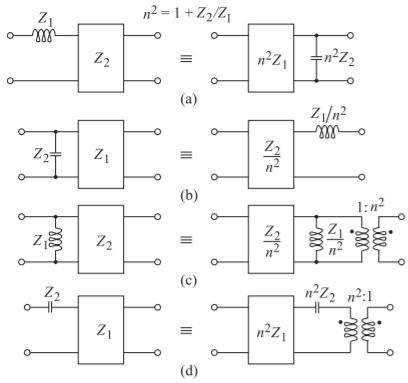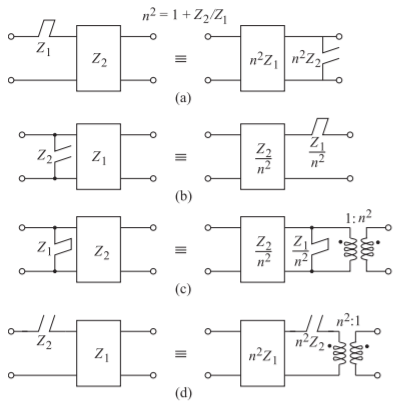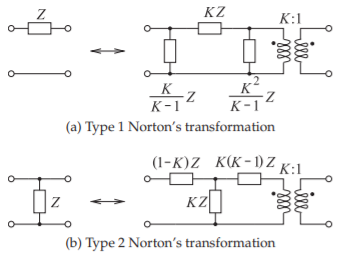2.13: Kuroda’s and Norton’s Network Identities
- Page ID
- 46074
Kuroda’s and Norton’s network identities are a number of pairs of equivalent networks that facilitate the transformation from one prototype to another, particularly transformations that enable realizable transmission line implementations.
2.13.1 Kuroda's Identities
Kuroda’s identities embody a number of specific manipulations using impedance or admittance inverters. They are particularly useful in implementing Richards’s transformations as they physically separate transmission line stubs, transform series stubs into shunt stubs, and can change characteristic impedances that are either too small or too high to practically realizable values. Kuroda’s identities are a number of equivalent two-port networks, as shown in Figure \(\PageIndex{1}\). The proof is derived by obtaining the \(ABCD\) parameters of the two ports similar to the technique used throughout this chapter. The identities shown in Figure \(\PageIndex{1}\) are narrowband. With stubs replacing the lumped elements, Kuroda’s identities then have broader bandwidths. Kuroda’s identities with stubs are shown in Figure \(\PageIndex{2}\). The major use of these identities is to transform designs with series stubs (in addition to possible shunt stubs) into designs with shunt

Figure \(\PageIndex{1}\): Kuroda’s identities. Here the inverters are impedance inverters and the designation refers to the impedance of the inverter. Recall that an inverter of impedance \(Z_{1}\) can be realized by a one-quarter wavelength long transmission line of characteristic impedance \(Z_{1}\). (As usual, element impedances are indicated.)

Figure \(\PageIndex{2}\): The stub form of Kuroda’s identities with impedance inverters. The stub impedances shown are the input impedances of the stubs.
stubs only.
To see how these identities are used, consider the identity shown in Figure \(\PageIndex{1}\)(a). The network on the left has a series inductor that, using transmission lines, is realized by a series stub. A series stub cannot be realized in most transmission line technologies, including microstrip. Using the identity shown on the right in Figure \(\PageIndex{1}\)(a), the series stub is replaced by the shunt stub used to realize the shunt capacitor. At the same time, impedance scaling

Figure \(\PageIndex{3}\): Transformation of a series inductor into a shunt capacitor between inverters.
can be used. If the impedance of the inverter in the network on the left is too low, then it can be scaled by a factor \(n^{2}\), where \(n^{2} =1+ Z_{2}/Z_{1}\).
One use of Kuroda’s transforms is to convert a series inductor into a shunt capacitor. Consider the inductor transformation shown in Figure \(\PageIndex{3}\). Figure \(\PageIndex{3}\)(a) shows that two inverters in cascade is electrically equivalent to an inverting transformer. Since each inverter is a unity inverter (either a \(1\:\Omega\) impedance inverter or a \(1\text{ S}\) admittance inverter), the equivalence is a unitary inverting transformer that corresponds to a \(180^{\circ}\) phase change. So the transformation of a series inductor begins with the transformation of the inductor (with value \(x\)) in Figure \(\PageIndex{3}\)(b) into the network of Figure \(\PageIndex{3}\)(c) in which the inverter cascade and the inverting transformer cancel each other out. Using the Kuroda identity in Figure \(\PageIndex{2}\)(a), the network in Figure \(\PageIndex{3}\)(c) converts to the electrically identical network in Figure \(\PageIndex{3}\)(d). Since the \(180^{\circ}\) rotation usually does not matter in circuits, the final transformation shown in Figure \(\PageIndex{3}\)(e) is usually acceptable. (The rotation would only matter if there was another path between the input and output as then phasing would affect the way signals on multiple paths combined.) Now the capacitor in Figure \(\PageIndex{3}\)(e) has the numerical value \(x\), the same as the numerical value of the original inductor. This is a result of using unitary inverters. The key result here is that a series inductor is equivalent to a shunt capacitor flanked by two inverters.
2.13.2 Norton's Identities
Norton’s transformations enable the magnitude of lumped element values to be scaled [16, 17]. Norton’s transformations are shown in Figure \(\PageIndex{4}\) where \(K\) is the scaling factor. Additional elements are introduced in these transformations including possibly negatively valued elements. Generally these elements can be combined with other elements so that the elements to be realized are positive (e.g. positive capacitor) and the transformer can also be replaced through subsequent transformations using, for example, Kuroda’s identities.

Figure \(\PageIndex{4}\): Norton's transformations.

